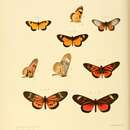Acraea acerata, the falls acraea or small yellow-banded acraea, is a butterfly in the family Nymphalidae. It has an extensive range in sub-Saharan Africa.
Range
It is found in Guinea, Sierra Leone, Liberia, Ivory Coast, Ghana, Togo, Benin, Nigeria, Cameroon, the Republic of the Congo, the Democratic Republic of the Congo, Sudan, Rwanda, Kenya, Tanzania, Zambia, Angola, Mozambique, north-western Zimbabwe, northern Botswana and northern Namibia.[3]
Description
A. acerata. Forewing black above with light subapical band and light hindmarginal spot, which is placed in 1a to 3, forms a spot in the cell and often encloses a black discal dot in 1b and in 2; hindwing above light nearly to the base, with or without black dots and with black, usually unspotted marginal band about 2 mm. in breadth. Hindwing beneath with reddish streaks in the basal part and with triangular, black-edged, yellow marginal spots in the lighter or darker marginal band.
-
acerata Hew. (56 a). Subapical band of the forewing in cellule 3 joined to the hindmarginal spot; light parts of the upper surface yellow-red. Ashanti to Angola and Uganda.
- f. vinidia Hew. (56 a). Subapical band of the forewing not reaching the hindmarginal spot; light markings of the upper surface brown-yellow to red-yellow. Commoner than the type form.
- ab. brahmsi Suff. only differs in having the light markings of the upper surface dark brick-red and the spot in the cell of the forewing absent or small. Nigeria and Cameroons.
- ab. diavina Suff. has on the forewing a small subapical spot, which only consists of three small spots in cellules 4 to 6, and large discal dots in cellules 1b and 2. Cameroons.
-
tenella Rog. is the East African race and is distinguished by the much lighter (white-yellow to whitish) colour of the light markings of the upper surface; the subapical band of the forewing is placed quite free. Nyassaland to Abyssinia.
- ab. ruandae Grünb. only differs from tenella in the large black discal dots in cellules 1b and 2 of the forewing. Ruanda.
A. pullula Grünb. entirely lacks the light subapical band of the forewing, but otherwise nearly agrees with tenella and may also be only an extreme form of acerata. Ruanda.[4]
Biology
The habitat consists of disturbed areas in the forest zone, usually near water or in riverine bush.
Both sexes show colour and pattern variation.
The larvae feed on Merremia hederaca, Lepistemon owariense, Solanum, Passiflora, Vernonia, Ipomoea (including Ipomoea whytei, Ipomoea repens and Ipomoea batatas) and possibly Zea species.
Taxonomy
Acraea acerata is a member of the Acraea bonasia species group see Acraea. Classification of Acraea by Henning, Henning & Williams, Pierre. J. & Bernaud
-
Hyalites (group bonasia) Henning, 1993 [5]
-
Acraea (Actinote) (subgroup acerata) Pierre & Bernaud, 2013[6]
-
Telchinia (Telchinia) Henning & Williams, 2010 [7]
-
Acraea (Actonote) groupe serena subgroup acerata Pierre & Bernaud, 2014 [8]
References
-
^ Hewitson, W. C., 1874 A list of Butterflies taken on the March to Coomassie by Lieutenant Alwin S. Bell, of the 2nd West-India Regiment, between Mansu and the River Prah, with Description of new Species Ann. Mag. Nat. Hist. (4) 13: 380-383
-
^ "Acraea Fabricius, 1807" at Markku Savela's Lepidoptera and Some Other Life Forms
-
^ "Afrotropical Butterflies: Nymphalidae - Tribe Acraeini". Archived from the original on 2012-08-10. Retrieved 2012-06-01.
-
^ Aurivillius, [P. O.] C. 1908-1924. In: Seitz, A. Die Großschmetterlinge der Erde Band 13: Abt. 2, Die exotischen Großschmetterlinge, Die afrikanischen Tagfalter, 1925, 613 Seiten, 80 Tafeln (The Macrolepidoptera of the World 13). Alfred Kernen Verlag, Stuttgart.
 This article incorporates text from this source, which is in the public domain.
This article incorporates text from this source, which is in the public domain. -
^ Henning, G. A., 1993 Phylogenetic notes on the African species of the subfamily Acraeinae. Part 2-3. (Lepidoptera: Nymphalidae) Metamorphosis 4 (1): 5-18, (2): 53-68
-
^ Pierre, J. & Bernaud, D., 2013 Nymphalidae XXIII. Acraea subgenus Acraea Butterflies of the World 39: 1-8, pl. 1-28 Goecke & Evers
-
^ Henning, G. A. & Williams, M. C. 2010 Taxonomic notes on the afrotropical taxa of the tribe Acraeini Boisduval, 1833 (Lepidoptera: Nymphalidae: Heliconiinae) Metamorphosis 21 (1): 2-38
-
^ Pierre & Bernau, 2014 Classification et Liste Synonymique des Taxons du Genre Acraea pdf

